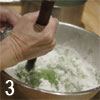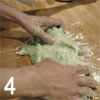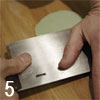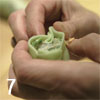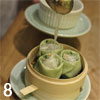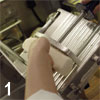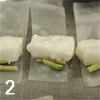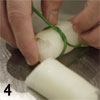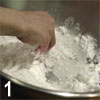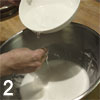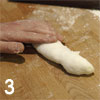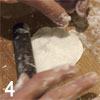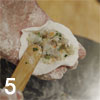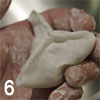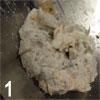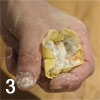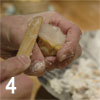Steamed dim sum
Some aspects of steamed dim sum making requires a lot of practice before the necessary dexterity becomes second nature. Other sides to it are straightforward, within the compass of any competent chef whether occidental or oriental. At Alan Yau's Soho restaurant, Yauatcha, both styles co-exist - plus everything in between. The emphasis though is on taste, on freshness, on prime raw materials and on a system that ensures each portion reaches the customer as it should -piping hot.
Dim sum are snack food, in the same way that tapas or mezze are. Traditionally, they belong to the culture of the "tea house", which in classical China often doubled as a brothel.
Hong Kong, today enjoys a reputation for being the world dim sum capital. Here, even the most sophisticated kinds are identified with daytime grazing, rather than dinners and fine dining. They are served at every level of eating place from staff canteens to the most luxurious eateries where the dough wrappers may be modelled to look like flowers or animals and the ingredients may include high status food like shark's fin or abalone and where decorations include gold leaf.
Recipes run into hundreds. The main categories are steamed dumplings, steamed buns, deep fried pastries and croquettes, plus sweets like Daan Tat, custard tart.
At Yauatcha, the emphasis is upon quality without too many over-fancy flourishes. There are few compromises, except perhaps in the generosity of the portions. A portion of enoki and prawn dumpling is composed of three 50g pieces. Typical customers who order four kinds of dim sum at a sitting are not going to leave the table hungry.
Chinese chive dumpling
The green dough for this skin is made from gluten-free flours, a combination of wheat starch and potato flour. The surface for preparing the skins must be wooden and flat (marble or stainless steel will not work as the skins will stick to the surface).
Chinese chefs usually work by eye and experience rather than weighing. In this instance though, the potato flour is measured but the liquid is not.
Allow three dim sum per portion.
Ingredients
For the Chinese chive dough (enough for about 50 skins. The proportion can be halved, but it's not easy to work with smaller quantites than this)
400g wheat starch
100g potato flour
boiling chive water - about 200ml, may be a little more
For the prawn and chive filling (enough for 12 dim sum but scale up as necessary)
75 g flesh from squid tubes, minced
275 g raw medium-sized prawns, peeled and coarsely chopped
1 large bunch Chinese chive flower, finely chopped
30 g carrot brunoise
30 g fresh shitake mushrooms, finely chopped
40 g potato starch (mixed with water to make a thin paste)
20 g wheat starch (same as potato)
2 tsp sesame oil
2 tsp vegetable oil
Pinch of sugar
Pinch of salt & white pepper
Note 1: To make chive water, finely chop a 100g bunch of Chinese chives. Put into a pan with 500ml water. Bring to the boil. Infuse to extract the colour. Strain the liquid into a fresh pan and return to the boil (1).
Note 2: Dissolve 1tbs wheat or similar starch in 2tbs cold stock. Pour over 250ml seasoned chicken stock. Put in a pan and heat till thickened. Add 100 g flaked white Black Fin crab meat. Chill.
Method
Combine both flours. Pour over the boiling liquid, a third at a time (2). Stir with a wooden spoon. Chef Wong uses a thin wooden rolling pin (3). When the dough has come together and is cool enough to handle, turn it onto a work surface and knead it by hand for about five minutes until it becomes springy (4). Wrap it in film until ready for use. The skins should be made from fresh warm dough and used at least within half an hour otherwise it becomes impossible to roll.
To make a chive dumpling skin requires practice and dexterity. Chef Wong uses an unsharpened cleaver and a folded, lightly oiled cloth.
Roll out a sausage from 200g approx. of the dough. Fold the ends of the dough in towards the middle, press down and roll out again. Repeat the folding and rolling process a further two times. The finished roll should be roughly 3cm in diameter and cut into 12 equal pieces. Take a piece of dough, press it with the palm of your hand and then work it, like a bread roll, to form a slightly flattened disc.
Grease the cleaver on the oiled cloth. Draw the cleaver flat across the dough so it forms a round, thin ‘raviolo' (5). Before making each skin, brush the cleaver over the cloth.
To make the filling, mix all the ingredients together to form a consistent mass. Marinate in the fridge for two hours before use.
To make each dim sum you'll need one chive dough skin, 1tbs prawn and chive filling and one scant tablespoon of crab sauce (see Note 2).
To assemble the dumpling, lay a skin in the palm of one hand. Using the other hand and a small spatula take 20g of filling (6). Mould the dumpling skin sides up around the mixture so that it begins to look more crescent moon in shape - note, the top edges should not touch. Using your fingers create two pleats in the skin at each end of the crescent shape and then fold the edges in to the sides (7). This should create an open-ended cylindrical shape to the dumpling.
Line a small bamboo steamer basket with a square of fresh banana leaf. Arrange the three dim sum on top. Spoon enough crab sauce on each dim sum to fill the pocket (8). Steam for 4-5 minutes or until the seafood is cooked.
Chilean seabass mooli roll dim sum
To prepare the Mooli (Mori or Daikon) skin Mooli grow to weigh as much as 20kg. The optimum size and shape for slicing should be as thick as an average forearm and more than 15cm long. It should weigh around 1 kg. Slice off the ends. Peel the skin and cut the mooli to form a rectangular block - like a brick.
Put the block of mooli on a slicing machine (setting 2). Slice it into strips about 2mm thick, 7cm long and 4cm wide (1) - or use a mandolin. Blanch the slices about 10 seconds in boiling water and refresh them.
To prepare the sea bass Fillet and skin the sea bass (a Chilean sea bass weighs between 750g -1g). Cut the flesh into batons: 5cm x 2.5cm x 2 cm. For each kilogram of prepared batons, whisk one egg white with one teaspoon potato starch and roll the fish in the mixture. This allows the fish to adhere to the mooli.
To prepare the Thai spring onion Cut the Thai spring onions into 4cm lengths. Heat a little vegetable oil in a wok until very hot. Stir fry the onion for 10 seconds and drain. Season with salt, sugar and a dash of sesame oil.
For each dim sum (allow three pieces per portion): 1 mooli skin
1 piece Thai spring onion
1 strip fresh ginger julienne
1 x 25g baton of sea bass
1 blanched Chinese chive with flower bud intact
Lay the skin flat. Arrange the spring onion and the ginger across the centre. Put the fish beside it (2). Wrap the mooli around the fish (3) and fasten with the chive (4).
Line a small bamboo steamer basket with a square of fresh banana leaf (5) and steam for four minutes or until the fish is cooked. Serve (6).
Prawn and enoki mushroom dumpling (dim sum in water steamed skin)
After steaming this dumpling the skin is tacky and almost clings to the chopsticks when picked up. Allow three per portion.
Ingredients
For the skins
500g approx. potato starch + extra for dusting
50ml warm water
Boiling water
For the enoki filling (enough for 12 dim sum but scale up as necessary)
125g fresh Enoki mushrooms chopped
30g fresh Shitake mushrooms, finely chopped
30g carrot brunoise
30g celery, finely chopped
250g prawns (raw king prawns, peeled, trimmed, roughly chopped and mixed with a pinch of salt and white pepper, and a little potato/wheat starch paste)
30g crab meat (raw white body meat only, finely chopped)
Mix the starch and the warm water in a bowl (1). Add boiling water, about 100ml at a time (2), beating it in well with a wooden spoon until a glossy dough forms, resembling something similar to cooked egg whites. Knead the dough while it is still hot until it becomes silky smooth. Wrap it in film until ready for use.
The skins should be made from fresh warm dough and used at least within half an hour otherwise it becomes impossible to roll. Roll out a piece of the dough to form a sausage (3). It should be roughly 3cm in diameter. Break a piece off the end the size of a large hazelnut. Dust the work surface with starch. Press the piece with the palm of your hand to form a slightly flattened disc and pin it out with a rolling pin to form a round, thin ‘raviolo', about 7cm in diameter (4).
Mix together the filing ingredients. Then, for each dim sum, form an open pocket with the skin. Three-quarters fill the skin with the filling (5). To seal the dumpling, make three crimped pleats that join in the centre (6).
Line a small bamboo steamer basket with a square of fresh banana leaf. Arrange the three dim sum on top. Invert them so that the three seams are on the underside resting on the banana leaf. Steam for around 3 ½ minutes or until the seafood is cooked.
Scallop Shumai
Shumai, an open as opposed to sealed dumpling, is probably the most simple dim sum to make since you can use ready-made wanton skins rather than a fresh dough. The skins are widely available in most big cities where there is a Chinese community.
For the prawn filling: 800 grams peeled, raw medium-sized prawns
30 grams finely grated carrot
40 grams Potato starch (mixed with water to make a thin paste)
20 grams Wheat starch (same as potato)
2 tsps Sesame Oil
2 tsps Vegetable Oil
Pinch of sugar
Pinch of salt & white pepper
For each dim sum (allow three pieces per portion):
1 wanton skin
1tbs prawn filling
1/2 scallop
1 pinch Tobika Akka (flying fish) roe
Note: Choose scallops that are on the small side, about 3cm in diameter. Remove the roe and the frilly mantle. Slice in half through the waist.
Method
To make the prawn filling, combine the ingredients (1), cover and leave to marinate for two hours in the fridge before use. Each shumai holds about 20g of the mixture.
To finish, cut out a circle from the skin with a 7cm diameter cutter (2). Form a pocket with it. Pack it with stuffing (3), flattening the surface with a spatula. Place the scallop on top and press into place (4). Line a small bamboo steamer basket with a square of fresh banana leaf. Arrange the three dim sum on top (5). Steam for 4-5 minutes or until the seafood is cooked. Garnish each piece with a little of the fish roe (6) and serve immediately.
Chilli dipping sauces
Mainstream Chinese restaurants often buy bottled, branded dipping sauces but it's better to prepare your own. There are dozens of versions. The Yauatcha version includes dried shrimp and is complicated. Here is a simple alternative taken from a recipe in Malaysian Cookery (Penguin) by Rafi Fernandez:
Coarsely blend 100g dried shrimp in a food processor. Split and seed 20 large dried chillies; slice into thin rings. Heat 3dl sunflower oil in a wok until smoking. Add the chillies and shrimp. Stir-fry until fragrant and pour into a bowl to cool. Season with a little salt. Store in an airtight container.
This sauce can be sweetened to taste with palm sugar, or made acidic with vinegar.
Chiu Chun Wong
Alan Yau and his Hakkasan head chef, Tong Chee Hwee are the brains behind the Yauatcha menu. They globe trot non-stop in search of new recipes to complement their menus. They also hunt for key skilled staff, and it was on one such trip that they encountered Chiu Chun Wong, the dim sum chef at Hong Kong's Marco Polo Hotel. Chef Wong has been preparing dim sum for over 30 years, becoming a "Master" in 1992 whilst working in Shanghai.





